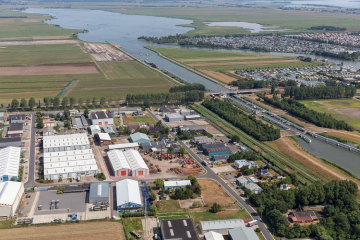Per and polyfluoroalkyl substances, or PFAS, are in countless goods in our world. They are also showing up in our air, water, and landfills as a POP – or a Persistent Organic Pollutant. Some POPs have half-lives of over 100 years, as such they’re pervasive in our environments, which is why they’re referred to as “forever chemicals.” Most industries don’t know where or how much PFAS is in their supply chain.
PFOA and PFOS are the two best known PFAS, and therefore the most researched. While no longer manufactured in the US, they still are produced in other countries and have essential uses in many every day products. PFOA specifically is classified as “likely carcinogenic” for prostate, testicular, bladder, liver, and kidney cancer.
In a webinar hosted by Antea Group, Scott Recker leads a conversation with two of our leading PFAS and remediation consultants, Caron Koll and Jack Sheldon, to describe why we should care about PFAS, the complexities in identifying PFAS risks for businesses, and the latest developments for remediation.
If you missed the live broadcast, you can still watch the full webinar on-demand.
Watch On-DemandWhy Should We Care About PFAS?
- PFAS have been used in commerce for over 70 years, and they’re in countless products
- They’re still mostly unregulated
- They have adverse health effects – Especially PFOA
- They are classified as a Persistent Organic Pollutant (POP) under the Stockholm Convention
- PFAS are the subject of increased litigation
- Products containing PFAS are not labeled
What Are The Complexities of Identifying Business Risk Around PFAS?
1. Multiple Definitions
First, there are multiple definitions of PFAS. There are at least 9 different definitions, and what is defined as a PFAS varies depending on who you ask. The EPA has a broad definition that includes over 12,000 different PFAS. On the other hand, the Organization for Economic Cooperation and Development, or OECD, has a narrower definition of PFAS with 4,700 defined chemicals in commerce.
If you’re screening for PFAS in your business, the recommendation is to always take the broader approach first, and then narrow it down as you continue through your own risk review.
2. Essential Uses
Unfortunately, PFAS is the only effective chemical in certain situations. For example, PFOS is used in fire-fighting foams, hard metal plating in closed-loop systems, and in agriculture for insect baits that contain sulfluramid to control leaf-cutting ants.
PFOA is used in the semiconductor industry and in medical devices. Right now, these are all still allowed applications of PFAS because there are no other alternative chemicals that meet the performance standards for the intended use.
3. Inconsistent Regulations
Different regulations occur for PFAS from state to state, country to country, and even region to region. That can make it hard to establish clear-cut regulations around these forever chemicals. Different organizations all have their own regulations around PFAS, too.
There are also differences around the world in how countries handle PFAS. Australia has the strongest restrictions and cleanup processes. On the other hand, the US and Europe are not as far along as Australia, but their regulations are ramping up now. Asia is just beginning to evaluate PFAS and their regulation of it. South American countries have PFAS on the radar.
There is also a reporting regulation gap. The level of concern or health advisory level in the US for one PFAS, PFOA, is 0.0000000004 ppm. That means a lot goes unreported to consumers and industries because they aren’t required to report anything under 10,000 ppm nor chemicals that are not listed as a hazardous substance on Safety Data Sheets. PFAS screening can fill this void.
4. Incomplete Science
There isn’t enough research for all PFAS compounds. In fact, many compounds don’t have any research on them at all. So, there are still a lot of unknowns.
5. There are too many PFAS to regulate.
Basically, there may be too many different types of PFAS to regulate individually. But, one thing is for certain, we can’t treat all 12,000 plus different PFAS as having the same risk. PFAS properties, behavior in the environment, and health effects vary, which makes it hard to actually regulate.
What Developments Have Been Made in Remedial Options?
We’re seeing more treatments at industrial sites, a shift toward in-situ technologies (below ground application of remediation), development of a Monitored Natural Attenuation (MNA) protocol, increased use of conventional tools such as GAC, IX, RO excavation, landfilling, and incineration. Treatment trains (combination of technologies) will also become very important.
Finally, there are new technologies such as plasma treatments, electrochemical oxidation, sonolysis, RemiBind®sorbent™, thermal, and more that are moving from bench scale to field application.
Remediation Technologies in the Spotlight
- Plume Migration Control – PlumeStop® from Regenesis – This is where tiny carbon particles are distributed into the subsurface and sit there as a capture zone for PFAS, keeping them from moving. This technology will remove other organic contaminants, not just PFAS.
- Service Active Foam Fractionation – SAFF® Foam Fractionation from Allonnia – This is the introduction of air bubbles to create concentrated PFAS containing foam at the air water interface (usually done in above ground vessels).
- Fluoro-Sorb® – from Minerals Technologies/CETCO - This is a series of modified clay materials that adsorb PFAS and is used in treatment vessels for drinking water and groundwater, barriers, mats, and mixed into soil. It is lower in cost than other medias and works with many different types of PFAS so it’s versatile and specific.
- PerfluorAd® – from Cornelsen/TRS - This is an infrastructure cleaning chemical process. Using above ground tanks and pumps, it removes PFAS wastes from fire suppression systems, tanks, and fire trucks within a few days. It also resists interference from other chemicals, unlike most other treatments.
Four Actions You Can Take
1. Desktop PFAS Screening (Audit)
Companies should do audits because many don’t know they have PFAS, but they could be on EPA’s and states target lists.
2. Eliminate PFAS in your supply chain including subcontractors
Companies should always expect the unexpected. Expect to have PFAS even if you don’t think so. Examples of products with possible PFAS include essential oils, solvents, gasoline, flavors, fragrances, kerosene, and more. Companies need to be aware of what contractors bring onto their site, because anything can contain PFAS, so proper management and disposal of PFAS-containing products is important. Companies should explore non-PFAS containing alternatives.
3. Emergency Planning Considerations
Plans are important, as are AFFF Management Plans. For example, for a Petroleum Fire Plan, you need a containment system, a way to collect fire water when it’s safe, a vacuum truck with emergency vehicles, and a high-pressure wash for surface cleaning. If PFAS is discharged to soil then you have to excavate as soon as possible, and finally you should pre-plan your disposal process.
4. Inventory and dispose or return existing supplies containing PFAS
- Landfills (preferred method right now) – The US has landfills that will take PFAS in Nevada and Idaho. There may be limited other options including transportation to Canada.
- Incineration - There is worry that the temperature can’t really be hot enough to destroy PFAS by-products. So, this is risky. There is a need to hold off on incineration until proper guidance is provided by the EPA and better air analysis methods are developed.
- Deep well injections – This is a disposal method that is not recommended but still exists in the US. Right now, this is pretty much off the table even though it is still listed by EPA as an option. Future guidance is expected from EPA in 2023, but this option probably won’t be around for much longer.
While these disposal methods have limitations, there is optimism for the future in terms of finding new volume reduction and destructive technologies for getting rid of PFAS. To solve this problem, we need more versatile technology at a lower cost with an emphasis on PFAS destruction.
Take the Offense And Start Assessing And Managing Your Risk Today
It’s important to keep track of regulations because they change frequently – even daily – in the USA and globally. You can use audit tools to manage risk, but you should be aware it’s complicated and pitfalls will pop up. Remediation technology is becoming more effective and less costly. Now, there are more ways to manage risk. Finally, there are source and risk reduction measures available now that weren’t available in the past, so take advantage of those and match them to your business risk tolerance.
If you feel stuck and need advice on how to get started with your PFAS risk, reach out to our team of experts today.
Want more news and insights like this?
Sign up for our monthly e-newsletter, The New Leaf. Our goal is to keep you updated, educated, and even a bit entertained as it relates to all things EHS and sustainability.
Have any questions?
Contact us to discuss your environment, health, safety, and sustainability needs today.









